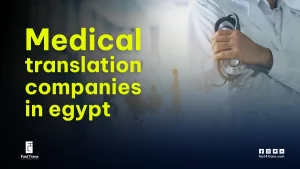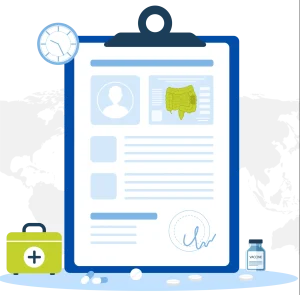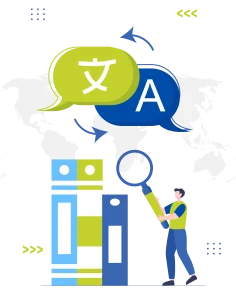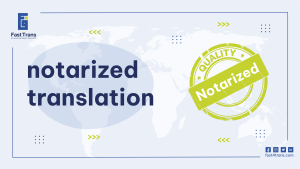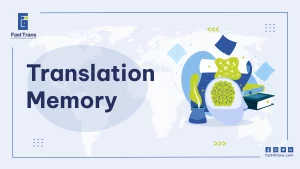Arabic medical translation ensures accurate communication of medical information between Arabic and other languages. This specialized field covers various documents, Arabic Medical Translation Types including patient reports, medication leaflets, research papers, medical device manuals, patents, and clinical trial forms. Accurate translation is crucial for patient safety, informed decision-making, and effective healthcare delivery in Arabic-speaking regions.
What is Arabic Medical Translation?
Arabic medical translation is the process of translating various medical documents, periodicals, medications and pharmaceutical leaflets, medical sets manuals, clinical reports, etc. from Arabic to other languages, or from other languages into Arabic. Many countries, especially in the Middle East and North Africa, require medical companies and institutions to translate their publications into Arabic to ensure they are easily understood and can be properly utilized. The Arabic medical translator is obliged to adhere to the highest standards of quality in translating medical documents. These documents are so sensitive, and any mistranslation, even a seemingly small mistake, can severely impact a patient’s life.
Arabic Medical Translation Types
Arabic medical translation encompasses various document types, crucial for healthcare in Arab-speaking regions. These include translating medical reports, patient information, medication leaflets, academic research, device manuals, patents, and clinical trial forms, ensuring accurate communication and understanding for both patients and professionals.
1. Medical reports and scans
Most patients in Arab countries, especially those with serious cases, may choose to be diagnosed by professional physicians from all over the world. This urges the need to accurately translate medical reports and scans into Arabic and conduct the correct diagnosis. It’s noteworthy that the translation of these reports has to be carefully done because it’s a very serious issue; namely, any unintentional change in a single word can lead to catastrophic medical aftermaths. Medical reports translation into Arabic, thus, is one of the biggest challenges in medical translation within the Arab world.
2. Patients’ information forms and medical consent
The importance of medical translation greatly lies in cases when the language of the patient in an Arab country is different from the one of the healthcare workers, or when information needs to be shared with family members who speak a different language. The patients’ information has to be collected correctly and clearly and then translated into the patient’s language and the physician’s language respectively, including Arabic where relevant. The medical consents patients in Arab countries give to hospitals regarding serious measures or lifeline operations have to be accurately and meticulously translated into Arabic. The patients have to be fully aware of the measures they will go through before giving these consents.
3. Medications leaflets
Patients in Arab countries need to completely understand the contents of medications and pharmaceuticals. These leaflets, translated into Arabic, show how the patient should take his prescribed medication, the cases in which he’s not allowed to take it, the side effects, the flavors, the other medications the patient shouldn’t take with his prescribed one, and the other important guidelines that should be in his source language to understand them easily.
4. Academic Content and medical researches translation
Arabic medical translation helps to boost the exchange among medical experts from different countries regarding research relevant to the Arab world. It also helps to spread scientific research, medical journals, and periodicals within the Arab world and internationally.
5. Medical sets manuals
Medical translation into Arabic helps healthcare providers in Arab countries to know how to use the new medical sets and their specific and general guidelines.
6. Patent translation
When there is a novel idea in the medical field related to the Arab world, the need to translate its patent into Arabic is highly recommended to spread it out within the Arab world and internationally, and to protect it from theft. The importance of patents translation lies in the time when there is an urge to submit the idea to officials from all over the world. This Idea may interest someone who can adopt, support, and spread it out.
7. Clinical experiments forms
When the medications and pharmaceutical companies have a certain product that can put an end to certain diseases, they tend, in the first place, to conduct a group of clinical experiments to make sure of its effectiveness. In this case, medical translation, including into Arabic, can be of great importance as there are some patients in Arab countries who may not be willing to accept having these experiments upon them without knowing the smallest details of the medication and the procedures that should be taken while conducting these experiments, so the translation of these documents to its source language can be of great importance.
An additional (in-depth) type of medical translation that’s used extensively in the research sector, including within the Arab world, is Cognitive Debriefing, also known as Cognitive Validation, which is different from the types listed above.
The importance of Arabic medical translation
Arabic medical translation is essential for ensuring clear communication and patient safety within Arabic-speaking healthcare settings. This specialized translation field bridges language and cultural gaps, enabling accurate diagnoses, effective treatments, and the global exchange of medical knowledge, ultimately improving healthcare outcomes and combating health crises.
- Helps Arabic-speaking patients and healthcare workers regarding the procedures taken in the treatment journey.
- Reduces the possibility of misunderstanding among physicians, nurses, and patients in Arabic-speaking contexts because of language, culture, and knowledge differences.
- Mitigates the possibility of wrong diagnosis or improper treatment plans in Arabic-speaking settings that can badly affect health problems.
- Helps to exchange experts in the medical realm among different countries and languages, including those specializing in Arabic medical practices, which boosts the chances of exchanging knowledge and scientific progress.
- Enables international healthcare organizations to provide high-quality healthcare services to Arabic-speaking patients around the world.
- Plays a crucial role in overcoming pandemics and international health crises as the fast and accurate translation of medical information into Arabic helps to spread the medical guidelines and important information for disease confrontation and healthcare provided to patients in Arabic-speaking communities.
Arabic Medical translation steps
Arabic medical translation involves initial information gathering and terminology research, followed by a systematic translation process in small, coherent segments. Accuracy is ensured through multiple revisions, including a break period, and final polishing focused on clarity, style, and client expectations.
1. Main information collection
The first step starts by discussing with the client to set the main general details of the Arabic medical translation project. The client, in this phase, understands the targeted audience demand, the document type, the word count, the used Arabic medical terminology, etc. the translator may have a first reading of the source text to get the gist of the document rapidly. He may make a list of the text’s Arabic medical terminologies and concepts and get in touch with the client to make sure they are all correct. He also may conduct general preliminary research on the Arabic medical topic at hand.
2. Doing the Arabic medical translation step- by- step
After getting the gist of the source text completely, the translator begins to systematically conduct the Arabic medical translation process by choosing a part consisting of 5-10 words each time. This part is an inseparable coherent whole to maintain its meaning and preserve the Arabic medical translation accuracy.
3. Double- checking the translated Arabic medical text to maintain its accuracy
What the translator does till now is a preliminary Arabic medical translation, but the next phase is to double- check the whole translated text and compare it to the source text. In this phase, the translator makes sure that he doesn’t explain, enhance, or interfere with the text by affecting its similarity with the source text and the used Arabic medical terminologies to have the same effect on the reader.
4. Take a rest in the middle of the Arabic medical translation process
This step is very simple as the translator is requested to put his work aside for a while and then have a second look. It’s noteworthy that rereading the text so many consecutive times for hours or even days can tire the translator and his concentration will be lost. Putting the Arabic medical translation aside, for at least two days if it’s possible, can let the translator get back to work actively and get ready for the last phase.
5. Final touches and complete revision of the Arabic medical translation
After the medical translator conducts his preliminary Arabic medical translation, revise it accurately, and make sure that there are no mistakes at all, such as grammatical blunders, punctuation marks, spelling, Arabic medical terminology misuse, or unclear and missing meaning. In this final phase, the translator will start to completely revise his Arabic medical translation without the need to compare it to the source document. His revision will focus on the expressiveness of words and sentences, the style clarity, and complexity. The translator should meticulously conduct his revision by searching for any ambiguous words, hard- to -understand ones, or misinterpreted ones. He also should embrace the client’s fear regarding the Arabic medical translation style and tone. Once he is done with these amendments, he will get a high-quality translated Arabic medical text.
What are the requirements and the characteristics of the Arabic medical translator?
An Arabic medical language expert must possess native-level fluency in both Arabic and the source language, coupled with a robust understanding of medical terminology and practices. They should also be adept at audience-specific communication, ambiguity avoidance, and ideally, simultaneous interpreting, while relying on human expertise over machine translation for precise, life-critical work.
1. Excellent command of Arabic and source language
The Arabic medical translator must have a strong command of both the source language and Arabic because the translated texts have to be accurately and authentically done.
2. Solid medical background
The ability to translate medical terminologies is a must. The Arabic medical translator, thus, has to have a solid medical background to be able to accurately and authentically translate these terminologies. It’s noteworthy that the commonly used words in our daily life can have different meanings than in the medical text.
3. Knowing audiences demands
It’s very important to know your audience’s demands from the text in hand. For example, the translation of a medication’s leaflet may vary if it’s directed to commercial purposes or physicians.
4. Ambiguity avoidance in Arabic
The translator has to exert his efforts to avoid using any ambiguous words in Arabic that may cause misunderstanding for the readers. It’s also necessary to revise the translation before its delivery to avoid possible mistakes and get rid of any linguistic ambiguity.
5. The ability to conduct simultaneously interpreting
The Arabic medical translator must be able to conduct simultaneously interpreting because he may need to use it in urgent situations. A tourist, for example, may need to get healthcare service during his vacation or a physician may need to interpret his speech to the audience as he attends a scientific conference full of different language speakers that are different from his native tongue.
6. Machine translation avoidance
While providing medical translation services, it’s necessary to manually translate the medical text as a whole without using machine translation. Machine translation may help you to get the gist, but it’s not designed to translate specialized medical terminologies.
Super commitment to the highest standards of translation accuracy
One of the most important characteristics of the translator is to professionally and accurately do his job. In medical translation, it’s very important to be so because a small mistake can endanger someone’s life.
The difference between a medical interpreter and medical translator
The medical interpreter is a specialized person who provides the oral interpretation services of the conversations between healthcare providers and patients who don’t speak the same language fluently. His presence is a must in the live medical meetings as he interprets the questions and answers between the physician and patient simultaneously. This type of translation requires having an excellent command of speaking skills and a deep understanding of the medical terminologies to have an effective and accurate communication channel between the physicians and the patients.
A medical translator is the specialized person in translating medical documents and texts from one language to another. He conveys the written information in the medical files, such as the patients’ reports, medication leaflets, scholarly studies, surgery paperwork, medical sets manuals, etc… From the source language to the target language. This is done by accurate, comprehensible, non-ambiguous translation. The medical translator has to be fully aware of the medical terminologies and concepts, and both language’s linguistic heritage to have an accurate, authentic and healthcare workers demands translation.
How can fast Trans Company help you with medical translation?
If you are searching for an accredited and authentic translation conducted by a medical translation team with a very long experience, search no further! We are, in Fast Trans Company for accredited translation, can offer you this service as per the highest standards of quality. If you, thus, make up your mind to partner with us, be sure that you will get the highest standards of accuracy and professionalism in translating the various medical documents on a timely delivery and super commitment to the international quality criteria. Don’t think twice and get in touch with us now to start working on achieving the goal you pursue.
Conclusion
Arabic medical translation is a specialized field focused on accurately conveying medical information between Arabic and other languages. This crucial service ensures that medical documents, ranging from patient reports and medication leaflets to academic research and clinical trial forms, are accessible and understandable in Arabic-speaking regions. Accurate translation is paramount in this field, as even minor errors can have significant consequences for patient safety and effective healthcare delivery. This type of translation facilitates clear communication between healthcare providers and patients, supports global medical research exchange, and enables the proper use of medical devices and pharmaceuticals within Arab communities.
Several Arabic Medical Translation Types cater to various needs within the healthcare sector. These include translating medical reports and scans for diagnoses, patient information forms and consent documents for informed decision-making, and medication leaflets for safe and effective drug use. Additionally, academic content, medical manuals, patents, and clinical trial forms require precise translation to advance medical knowledge and ensure regulatory compliance. Beyond these, cognitive debriefing, a specialized form of medical translation, plays a key role in research settings. The importance of Arabic medical translation extends to improving healthcare access, reducing misunderstandings, fostering international collaboration, and effectively addressing public health crises within Arabic-speaking populations.



